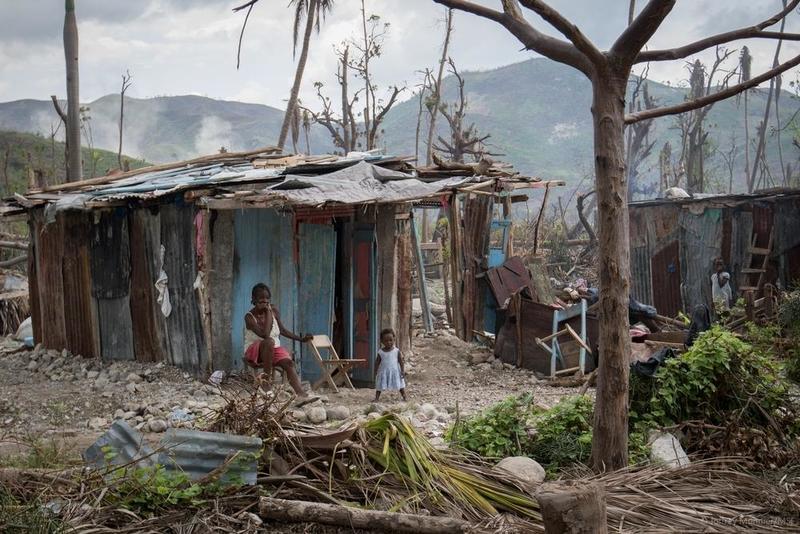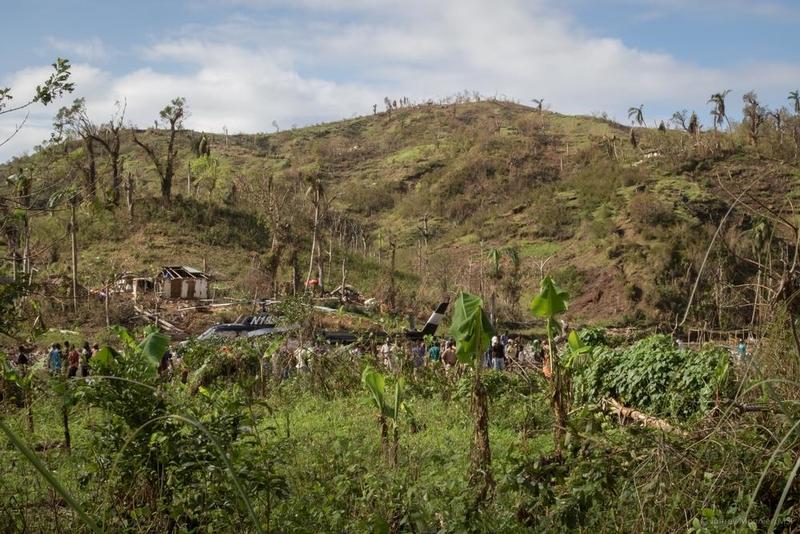Claire Reading is a midwife on assignment with MSF in Port-a-Piment, Haiti. Here, she blogs about helping a woman deliver her baby in the aftermath of Hurricane Matthew - an event that came with dramatic complications.
The hour long helicopter ride across southwest Haiti is beautiful, all the way from the capital Port-au-Prince, to my new home in Port-a-Piment.
From the air you catch glimpses of destruction - plastic sheeting lies everywhere, reminders of people trying to rebuild their roofs after Hurrican Matthew wrecked hundreds of thousands of homes.
As we land beside the ocean, the scope of the disaster becomes very clear. It appears even one month after the hurricane, people are still in desperate need of assistance.
Mounting pressure
MSF has been in Port-a-Piment since day four post-Matthew, but maternity care back then wasn’t as necessary as caring for cholera patients, providing clean water, and emergency healthcare.
As I arrive at the hospital, I’m greeted by a lot of smiles. The staff are happy to have a midwife. They tell me: "No complicated births for a month, no longer do we need to cross our fingers!" - this only serves to fuel the mounting pressure I'm feeling.

It’s 10:30 am, and we go straight into a briefing about the project – what is happening security wise, what MSF wants to achieve, and what our challenges are, both geographically and culturally.
At 11:00 am, I’m called to the maternity ward. There's a woman in labour. Right, let’s go!
The room is airy, with good lighting and a ceiling fan. This is a good start.
The woman in labour, Milaud, is having contractions. At 29 years-old, this is her third baby. I soon learn she's been in hospital since 07:00 am, and there has been no change in her progress.
I decide we should break her water. When I offer to support Maud or Louise (the nurses on duty), they run out of the room, telling me: "Next time, next time, Madame!" Eventually, Maud consents.
"Where on earth is this bleeding coming from? The uterus is firm, I cannot see a tear that needs suturing, and the placenta appears complete. Oh hell, I’m thinking."
After a lot of hard work on Milaud’s part, and lots of clean drinking water and support from us, Benjamin is born. It’s not the easiest birth I’ve facilitated - but soon the baby boy screams, letting us all know he is happy to be here, next to his mum.
Together, we deliver the placenta and I’m feeling rather smug that after five hours. Benjamin is the ninth little baby we have welcomed as an MSF supported maternity, here in Port-a-Piment.
Then the drama starts.
Life-threatening complications
Where on earth is this bleeding coming from? The uterus is firm, I cannot see a tear that needs suturing, and the placenta appears complete. Oh hell, I’m thinking. It can mean only one thing: a cervical tear. [[Article-CTA]]
I ask Maud to give Milaud an IV drip, and to increase the flow. I ask Louise to get me a flashlight and some sterile gauze. I’m starting to sweat, and beginning to feel a little out of my depth.
Maud checks the mother's vitals – she’s stable, so we put in a urinary catheter. I find the source of the blood loss - it’s like a tap has been turned on. I close the tear with my fingers and sterile gauze, and then call for the doctor.
I’ve seen this type of obstetric complication only twice in my career, once in London and once in Democratic Republic of Congo. In both cases, the women needed intensive care and blood transfusions.
In addition to this, the women with cervical tears required an operating theatre, general anaesthesia, and a doctor trained in gynaecology emergencies.
I had none of those.
"She begged me for food, but I couldn’t give her any, as I was sure they would give her a type of general anaesthesia. My mind was running - what if she bled out en route?"
It was getting dark, and we would soon need to arrange for a private ambulance and stabilise Milaud. However, as luck would have it, Dr Roland came to my rescue.
I put on my goggles, and our colleagues kept coming to ask if we needed anything. Logistics brought us the biggest cylinder of oxygen known to man – dripping sweat all over my maternity floor after hauling it up a flight of stairs!
Together we managed to put three separate sutures in the cervix, something neither of us had ever done before – and we managed that because of the partial prolapse, which we could hardly see.
I constructed a pad of cotton wool covered in an opened piece of gauze – this little tool would enable me to see how much she was bleeding.
We need a gynaecologist
I was feeling confident. Milaud's vitals were stable, and we gave her some more oral analgesia and water, and then - the bleeding started again.
Milaud had already lost so much blood that I started to really worry. We decided we had to get her out to a gynaecologist, one hour away by car.

She begged me for food, but I couldn’t as I was sure they would give her a type of general anaesthesia. My mind was running - what if she bled out en route? We couldn’t go with her.
Seven-and-a-half hours after arriving, Milaud and baby Benjamin (2.4kg) were on their way at to Port Salut, where Dr Stevenson would greet them and save her life.
Bittersweet relief
Two days after what was probably the most memorable first day in a new job, Milaud and Benjamin came back to the maternity in Port-a-Piment.
Sitting on a small metallic chair, she looked tired and weak, but beamed over the tiny baby. She gave me the prescriptions from Dr Stevenson, and I prepared her medications, explaining them after discussing what had happened.
It really was so important that Milaud came to the hospital on my first day. No woman should ever be another statistic in the maternal mortality reports - but the longer I work in rural settings, where there is either no skilled birth attendant or proper maternity care, that isn’t going to change.





